Despite California being in a seemingly constant state of summer, the meaning of cooking “seasonally” didn’t quite make sense to me until I moved from Connecticut to California. Growing up, the grocery store always seemed to be stocked with the same produce. If the recipe I circled in my Food Network magazine required a pomegranate, the store had a pomegranate. Granted, a very well traveled sad looking pomegranate, but that did not stop me from buying it.
Moving away from the wooded suburbs of Connecticut and to the lush land of California opened my eyes to where and how produce is grown, when it is harvested, and how long it might take to get into my kitchen. In the fall, I would run around Claremont looking for the best loquat and kumquat trees. In the winter, I picked sweet, juicy navel oranges from Pitzer’s citrus trees. In the spring I found massive bunches of peas of at the local farmers market. In the summer, I received bright red heirloom tomatoes from my neighbors garden. Now, in SF, I keep my eyes open to what roadside farm stands are selling, what farmers bring to the weekly market, and what is in abundance at grocers like Bi-Rite. (I frequently return home from Bi-Rite very enthused about the grapes or figs or cherries they had that day).
It seems obvious, but good tasting food depends almost entirely on high quality ingredients. When I started exploring the farmers market then deciding what to cook my dishes tasted infinitely better and I enjoyed cooking more. Washing and drying lettuce leans less perfunctory more inspirational when the lettuce is perfectly crisp and bright green.
When a vegetable or fruit is no longer “in season” that does not mean you should completely avoid it. If I find a fennel bulb that doesn’t seem quite at its peak, I might opt to saute it instead of shave it into a salad. Similarly, if my herbs are looking a bit sad, I may blitz them into a green goddess dressing instead of using them to garnish.
While it is indeed mid-December, it feels like just a few weeks ago I was strolling around SF looking for ingredients for a late-summer dinner party. At the Clement St. farmers market I found heaps of juicy tomatoes and a big bunch of zucchini flowers. At Bi-Rite I found a few intriguing passionfruits. Here is how I prepared my bounty:
Linguine alle Vongole
serves 8 people
Vongole is having its moment. and rightfully so. This dish is beautiful — fresh clams nestled in bundles of buttery, salty, garlicky pasta. It’s fun to eat and shockingly easy to prepare. The star of this pasta is the briney, buttery, garlicky wine broth with burst cherry tomatoes. It’s stunning on its own, sopped up by crusty bread, and most importantly absorbed into the linguine.
The seasonality of Vongole? Aside from the addition of ripe sungold tomatoes, this dish just feels like summer. You come home from a day at the beach, sip on an aperol spritz, and eat vongole. idyllic.
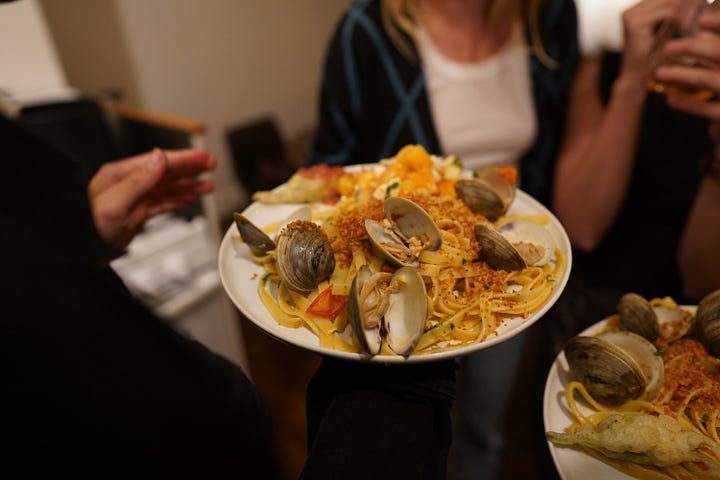
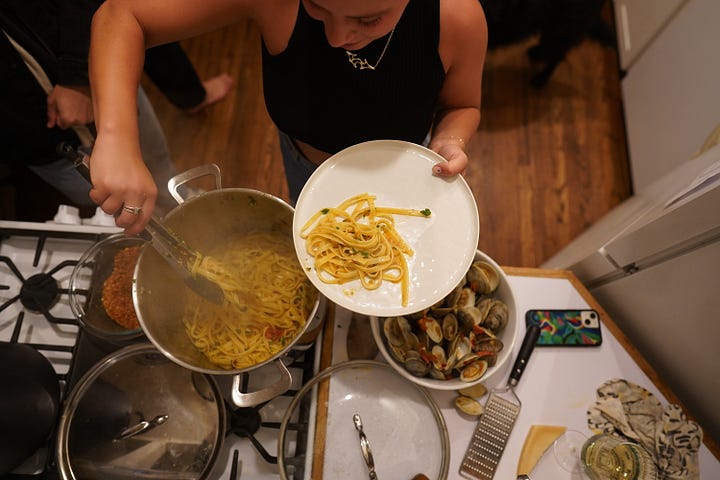
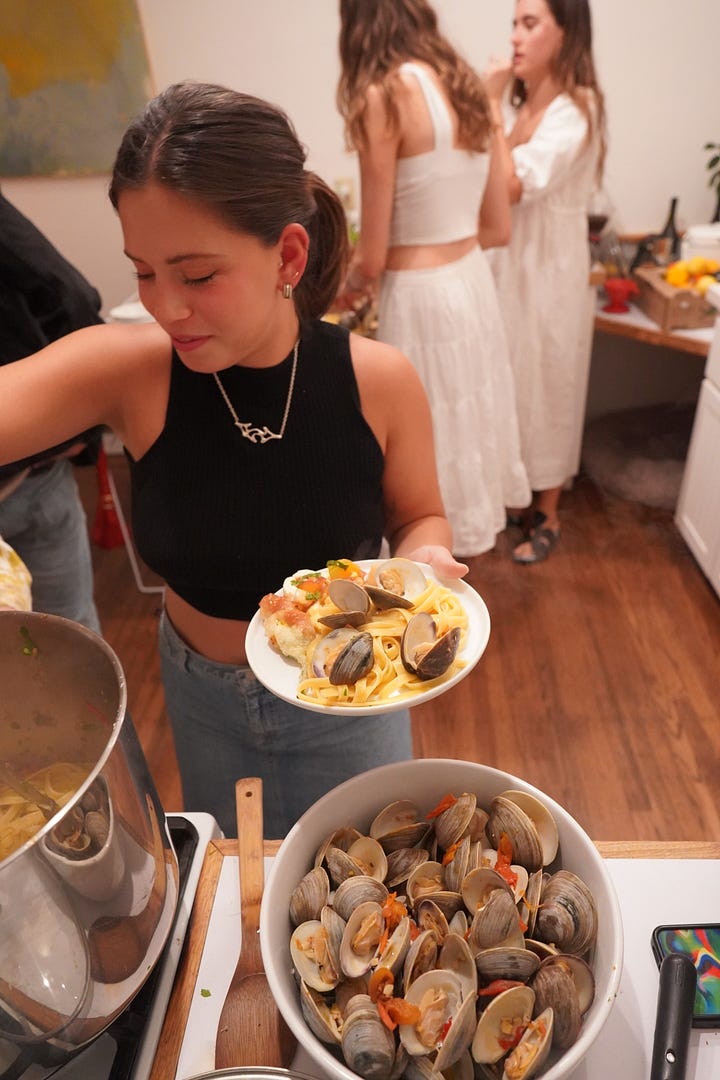
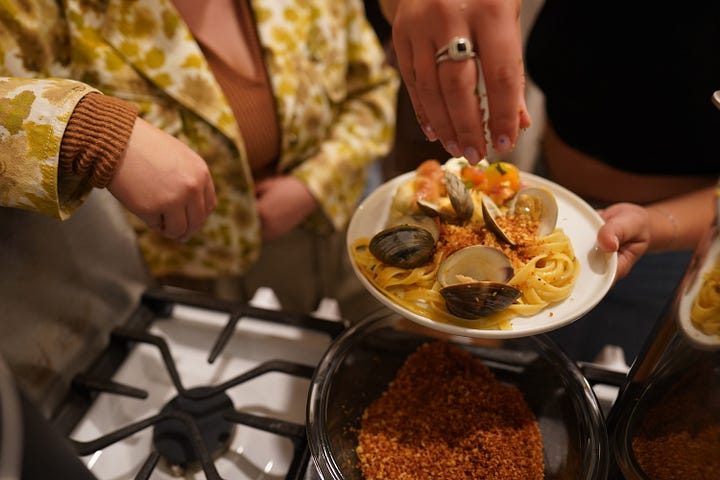
6 pounds of fresh Manila or little neck clams, soaked in water and picked through
10 cloves of garlic, finely sliced
2 tablespoons extra-virgin olive oil
~ 1 teaspoons chopped fermented, or fresh, Calabrian chili
1 shallot, minced
1 1/4 cup dry white wine, such as pinot grigio
2 pints cherry or sungold tomatoes
2 pounds linguine
For assembly:
1 cup bread crumbs or panko
2 garlic cloves
1 cup chopped flat leaf parsley
Saute garlic in a large saute pan or dutch oven with olive oil, add chili pepper and shallot
Meanwhile, bring a pot of salted water to a boil. Add linguine and cook for 2 minutes fewer than al dente.
Separately, toast bread crumbs in a pan with olive oil. When evenly browned, grate in 2 cloves of fresh garlic and toss.
When garlic/chili/shallot is soft, add cleaned clams, white wine, and a pinch of salt. Simmer, shaking the pot, until the clams open up. If you have a large pot of clams you may have to cover the pan for a few minutes. Remove the clams when open and set aside.
Add tomatoes to the pan and cook for one minute. Add linguine and toss in broth, cooking until the pasta is tender and the cherry tomatoes are just burst.
To assemble: twirl linguine on a plate with tomatoes and broth, nestle clams on top, then sprinkle on the breadcrumbs and chopped parsley.
Fiori di Zucca Fritti
Zucchini flowers first entered my vegetable vocabulary as “fiori di zucca.” My aunt in Sicily would take me to the market with her, where we would fill up a big paper bag with zucchini flowers to eat for lunch. At home, we would clean them, stuff them, then fry them. While I have prepared them in other ways, the process of stuffing/twisting/frying is deeply nostalgic and consistently delicious. When I stumble upon these beautiful vegetables at the farmers market it feels like a chance encounter - a rare moment that only occurs a few weeks during the year. I find that the freshest blossoms are a vibrant orange, not bruised, and wide open.
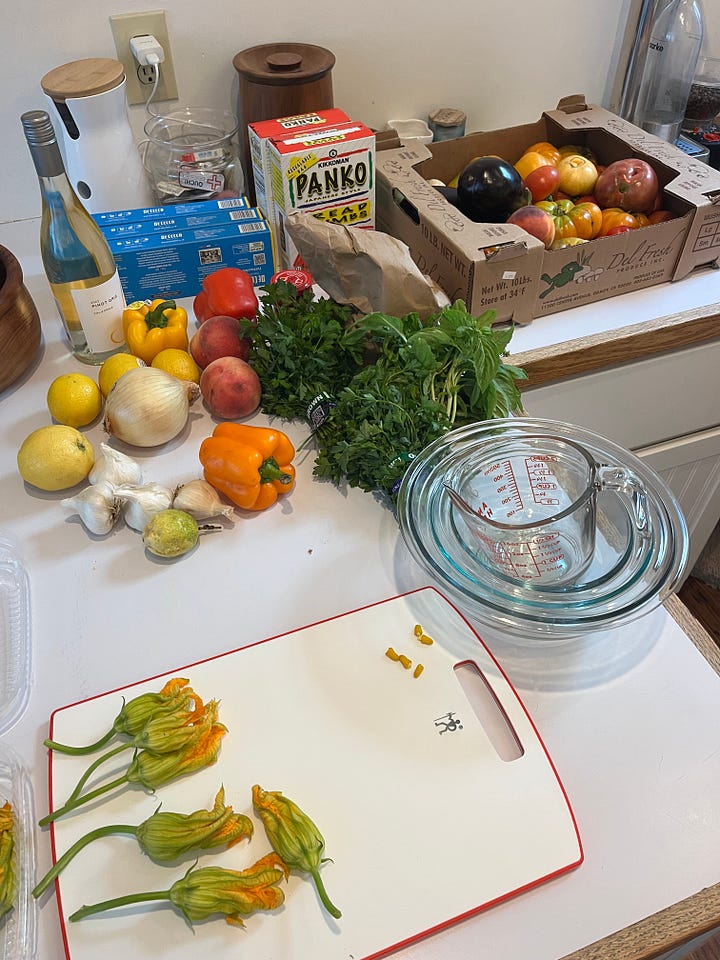
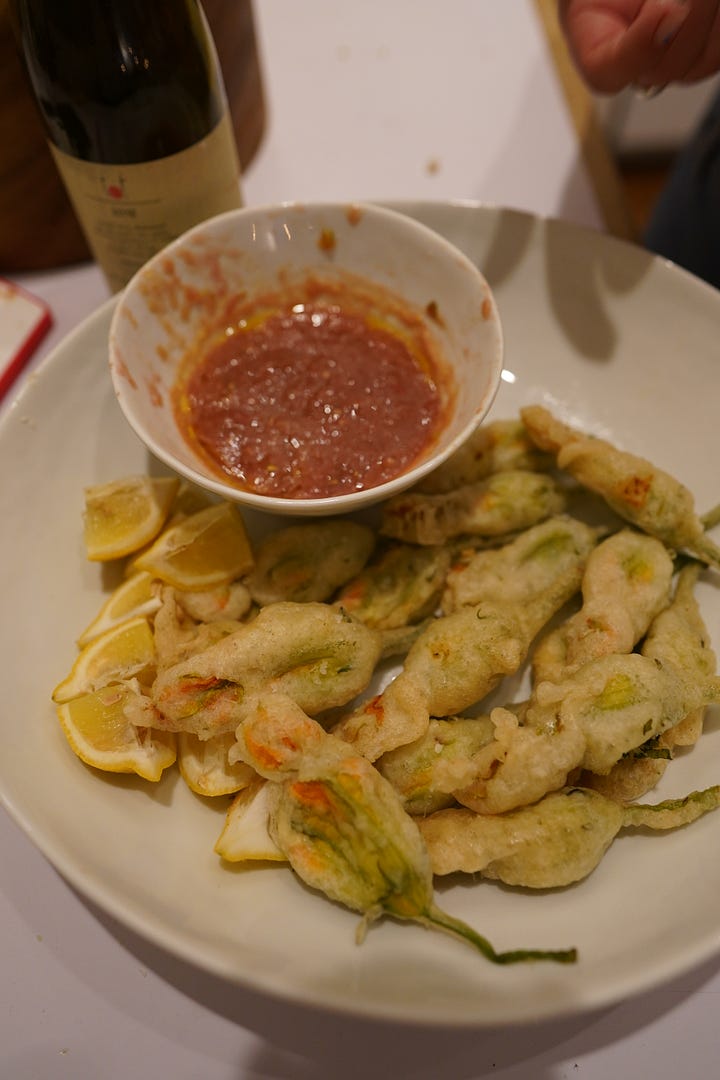
~1/2 pound of ricotta cheese
1 large egg, beaten
a small wedge of parmigiano-reggiano, grated
1 tablespoon melted butter
fresh basil, chiffonade
a tin of anchovies in olive oil
salt
pepper
1 cup of flour + 1 tablespoon
soda water
neutral oil for frying
For assembly:
Place flour in a bowl and season with a teaspoon of salt
Slowly whisk in the soda water until your batter is a thick-cream consistency
Gently pry open the flowers and remove the stamen (the little stem inside the flower) and inspect for any critters (I have found caterpillars many times inside these)
To prepare the stuffing, beat the ricotta, egg, butter, and parm together until smooth. Season with salt and pepper. Stir in the flour.
Add an anchovy to each blossom, then pipe the stuffing inside the blossoms. Fill each blossom about 3/4 of the way full then gently twist the petals together at the top.
While the oil is heating, drag the flowers through the batter, allowing excess batter to drip off, then slide into the hot oil. Fry until golden and crispy. Remove from oil and drain on paper towels.
Garnish with lemon and flaky salt. Alternatively, serve with a raw grated tomato sugo.
Burnt Basque Cheesecake with Passionfruit Curd
Passionfruit felt firmly exotic and novel until I realized that the vine growing along my front stoop was a passionfruit vine. While it never fruited, I spotted passionfruits for sale at my local grocer and bought a few to try. I love them. Especially in my morning greek yogurt bowls. Adding them to a cheesecake felt like the natural next step for my experimentation. It was divine. I followed Molly Baz’ burnt basque cheescake recipe (as I have made this many times and never disappoints) but this time added a passionfruit curd.
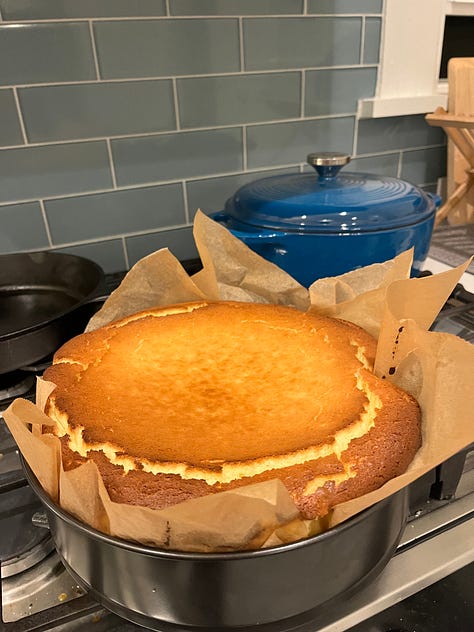
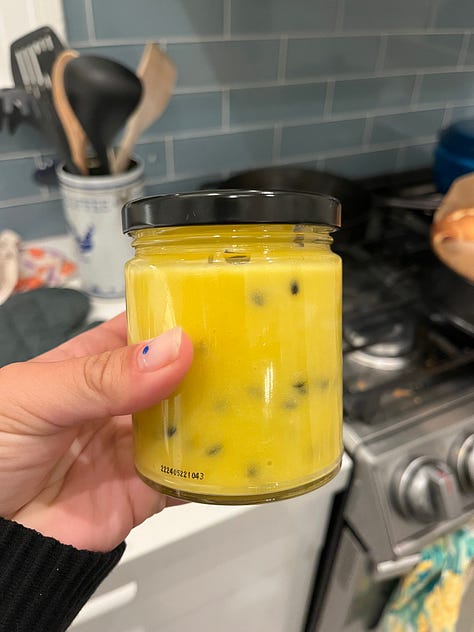

pulp of 3 - 4 passionfruits
2 tbsp lemon juice
6 tbsp butter
1/4 cup of sugar
4 egg yolks
steps:
heat passionfruit pulp and sugar in a small saucepan over medium-low heat, whisking until the sugar has dissolved
in a separate bowl, whisk together egg yolks and lemon juice
pour the passionfruit-sugar mix into the egg yolks in a constant stream, whisking constantly
add the mixture back to the saucepan with butter. whisk over low heat for 15 minutes or until thickened
cool well and enjoy.
enjoy!!! & make sure to stroll through your local farmers market with intention <3



